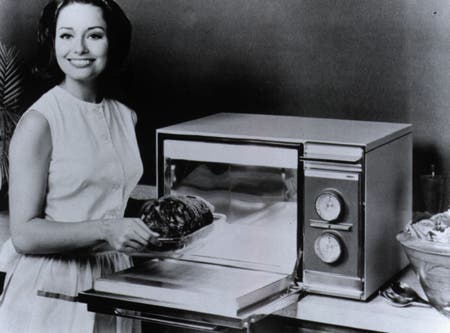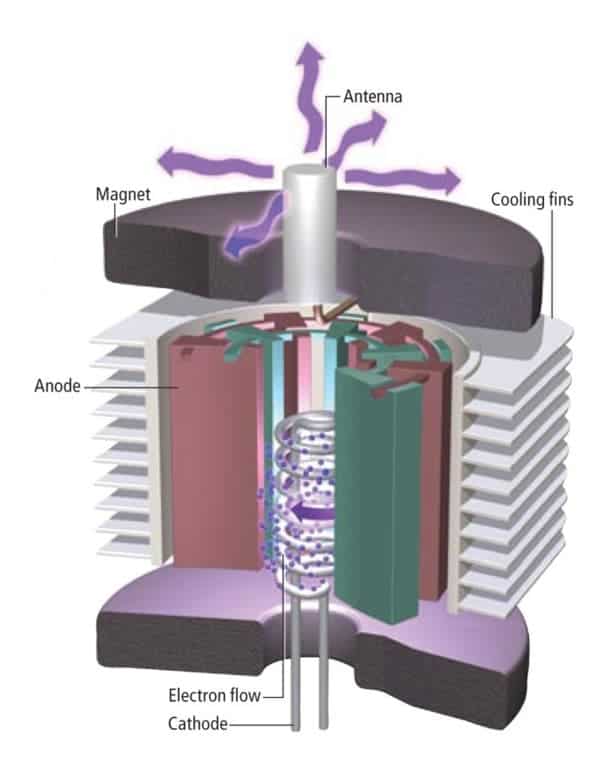Sometimes, weapons and other projects pushed by the urgency of war have been converted into civilian technology. Such is the case of nuclear power plants, the internet, but also radar tech, which unexpectedly and inadvertently led to the invention of the microwave oven — one of the most widely used home appliances in the world.
Radar and microwaves: how the microwave oven was invented
![Before and throughout the war, British ground radar technology was rather well matched by German scientific advances. Here, mid-war ground radar station FuMO 214 Würzburg-Riese [US National Archives]](https://cdn.zmescience.com/wp-content/uploads/2015/01/deflat4.jpg)
In 1920, a young physicist called Albert Hull, who worked at the General Electric Research Laboratory in Schenectady, New York, invented the magnetron tube — a coaxial cylindrical anode and cathode with an axial magnetic field produced by an external coil. It was a magnet that controlled electrical current inside an evacuated electron tube, or vacuum tube.
Hull believed the magnetron would be successful as an electrical converter, but 20 years later it would prove most useful in telecommunications. During WWII, the British were looking to devise a higher-frequency radar technology for the war effort. A radar locates distant objects by bouncing radio waves off of them and then analyzing the reflections. Locating the enemy from afar was crucial to the war effort.
Engineers planned to build a new radar system based on electromagnetic waves in the microwave region of the radio spectrum. Such a system would require smaller antennas and detect smaller objects than lower-frequency, longer-wavelength radars.
Microwaves correspond to a region in the EM spectrum defined by having wavelengths between approximately 1 meter and 1 millimeter, corresponding to frequencies between 300 MHz (Mega = 106 Hz = 106 sec-1) and 300 GHz (Giga = 109 Hz). Today, microwaves are often used to transmit data from satellites in space to radio dishes on Earth, but back then building a high-power source of microwave radiation proved to be a challenge.
In 1940, John Turton Randall and Harry Boot, two young physicists working in England at the University of Birmingham, found a way to modify Hull’s original magnetron tube to make it produce microwaves with high enough power. The improved design was called a cavity magnetron tube, and shortly after its first test runs it became the heart of the Allies’ advanced radar systems that were so essential — perhaps decisive — to the overall Allied victory in World War II.
From spotting Luftwaffe fighters to popping popcorn
During the war, one of the leading suppliers of cavity magnetron tubes was the Massachusetts-based Raytheon Manufacturing Company. Working there was a self-taught engineer by the name of Percy Spencer. One day, in 1946, while testing a new magnetron unit, Spencer felt a strange tingling sensation and suddenly noticed that the candy bar in his pocket had melted. He then placed popcorn, eggs, and other foods in front of the device and they all cooked — actually the egg exploded all over his friend’s face!
Shortly after the accidental discovery, engineers at Raytheon went to work on Spencer’s new idea, developing and refining it to be of practical use. A year later, the first commercial product hit the market. After a few decades of turmoil, myths and legends regarding microwave use, public demand began to swell with acceptance until the sales of microwave ovens eventually surpassed those of gas ranges in 1975.
Furthermore, in 1976 the microwave became a more common household appliance than the dishwasher as it found its home in nearly fifty-two million U.S. households, or 60% of U.S. homes at the time.

Although microwave ovens today have advanced since the very first designs, at their core they still use the same cavity magnetron tube that was harnessed so effectively for WWII radar.
How a microwave oven works

The microwave oven is quite a feat of physics and engineering. At its core, the oven exploits the polarity of water molecules which tend to rotate themselves into alignment with their positive ends in the direction of an electric field. With each rotation, the water molecule’s electrostatic potential energy is transferred into thermal energy.
An analogy would be a very crowded room, in which everyone is told to turn and face the stage. In doing so, people brush up against one another as they turn and friction causes the conversion of some of their energy into thermal energy. The magnetron reverses its electric field very fast, so water molecules flip back and forth at a rate of billions of times per second.

This heat is what actually cooks food in the oven. Because all particles in the food are vibrating and generating heat at the same time, food cooked in the microwave cooks much more swiftly than food cooked in a conventional oven where heat must slowly travel from the outside surface of the food inward.
The same radio waves that cook your food pass harmlessly through plastics, glass, and ceramics. It is this characteristic that keeps plastic plates from melting and glasses from exploding. It is also this feature of microwaves that makes them so energy efficient; they heat only the food and nothing more.
As you might have learned from experience (ouch!), metals reflect microwaves which is why they line the walls of the microwave such that no waves escape and cook anyone in the kitchen!
Was this helpful?



